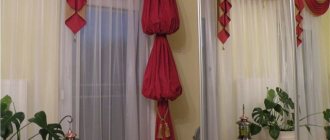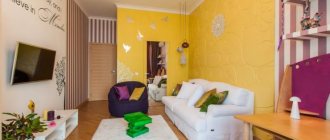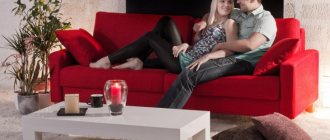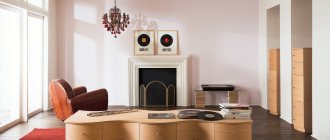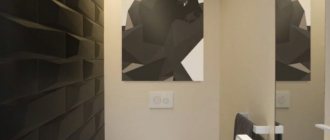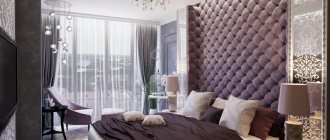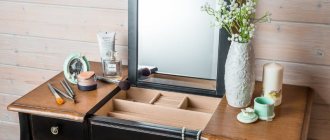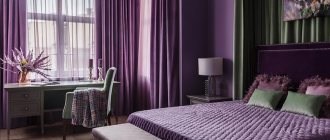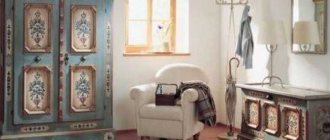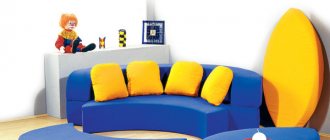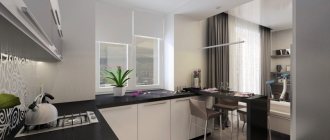Home » Partitions
Category: PartitionsAuthor: Avtor
The use of partitions made of various materials in the interior is most often due to the need to divide the space into functional zones. But such structures are also erected for purely decorative purposes for the aesthetic design of the room. There are monolithic, transparent and combined partition elements; they can also be stationary, sliding and mobile. Let's consider all the options for false walls and their functional and decorative qualities that affect interior design.
- 1 Types of decorative partitions in the interior
- 2 Brick partitions
- 3 Plasterboard elements in the interior
- 4 Forged interior partitions
- 5 Decorative glass partitions
- 6 Partitions with stained glass
- 7 Sliding partitions
- 8 Wooden partitions
- 9 Interior partitions made of fabric
Types of decorative partitions in the interior
To zone the space, various types of partition elements are used. They differ in design, decorative and functional qualities. Interior partitions are divided into three groups: stationary, sliding and mobile. And each of them is divided into additional subspecies.
Let's analyze the stationary options for partitions:
| Types | Material | Design features |
| Monolithic | Brick, blocks, wood, stone, glass blocks, tempered glass on a frame, drywall. | They have good sound insulation properties, are resistant to moisture (gypsum board and wood require a special coating for this), strong and durable. They require equipment for doorways if they are made from floor to ceiling. |
| Screens | Glass, carved wood, plastic. | Installed on special supports. They are quite durable, but it is impossible to hang cabinets and shelves on them. It is impossible to cover an entire wall with a screen without a passage. Carved and glass options have good light transmittance. |
| Shelving | Wood, plasterboard, tempered glass on a frame, plastic, metal. | They can be open, double-sided, combined, of any height. Installed on the floor or attached to the walls. Durable, convenient for storing household items, they come in various shapes and sizes, and are highly decorative and practical. |
| Partitions with fireplace | Brick, stone, blocks, metal. | If you place the fireplace inside the partition, the flame will be visible from anywhere in the room. In addition, the rest of the space, in addition to the air duct and the fireplace, can be equipped with shelves for memorable photos and souvenirs. |
Stationary partition elements can be chosen for zoning both small studio apartments and large living rooms in private houses. In the first case, a sleeping area or hallway or kitchenette is separated from the living room. Most stationary structures allow you to hang interior elements on them - mirrors, panels, shelves, which expands the decorating potential.
Stationary decorative partitions in the interior of the living room make it possible to limit the seating area, office or dining room (in case of a small kitchen). In the latter case, openwork carved partitions that do not reduce natural light too much are ideal. They will also provide a certain privacy without the feeling of an enclosed space when dividing the bedroom into a sleeping area and a boudoir.
Partitions made of glass or transparent plastic will be good for the dining room and kitchen due to light transmission, moisture resistance and ease of maintenance.
Sliding structures are both enclosing elements and doors. They zone the space, occupying a minimum area of the room. You can read more about the types of sliding partition structures and their decorative capabilities below.
As for mobile false walls, they include a variety of screens, as well as some types of shelving on wheels. They provide greater zoning flexibility and allow you to “redraw” the space at any time at the owner’s discretion.
Sometimes partition elements are used solely for decorative purposes, without dividing the room into zones. They are installed in the center of the room or near one of the walls.
The functionality of plasterboard structures in small apartments
Small apartments are known for their inconvenience due to poor layout and lack of space sufficient to accommodate standard furniture sets. These shortcomings can be leveled out using plasterboard structures.
- Wall niches, openwork partitions, racks and shelves in the living room interior will help you get by with a minimal set of furniture and equipment without overloading the room with unnecessary details. A flat-screen TV fits well into a large niche in the wall; flower vases, figurines, and sculptural compositions look great on decorative shelves.
- You can turn a one-room apartment into a two-room apartment using a volumetric partition made of plasterboard with internal shelving, which has enough space for bed linen, clothes and shoes, books and albums.
- In the bedroom, ergonomic organization of space is especially necessary, since excess furniture and cramped spaces significantly reduce the volume of air, which interferes with rest and restful sleep. Instead of huge bedroom sets in a Khrushchev-era apartment, it is wiser to limit yourself to a large, comfortable bed, and along the walls to place narrow wall shelves and plasterboard cabinets, convenient for storing bed linen and items of clothing.
- Shelves and niches, cabinets and partitions help to gain several meters of usable space in the nursery. In the baby's room, securely fastened, safe multifunctional structures look great, in which you can place everything you need. Bright fragments of your favorite cartoons, placed on shelves with internal lighting opposite the crib, will help your child overcome night fears.
USEFUL INFORMATION: Design options for a stylish bathroom: high-tech, modern, Scandinavian, marine
- A computer desk by the window in a teenager’s room goes well with a small niche in the wall into which the monitor is placed. On the shelves inside the partition you can place books, notebooks, writing instruments, models of fantasy ships and car models.
Built-in spot and LED lighting sources fit perfectly into wall and ceiling structures.
Brick partitions
You can create a stationary structure in a country house from brick.
Despite the massiveness and complexity of dismantling, such partition elements have many advantages:
- fire resistance;
- high noise insulation;
- availability of material;
- a variety of decorative coatings for the partition surface.
Using brick partitions, you can divide any room, regardless of humidity and temperature. Since this design is easy to decorate, the design of brick interior partitions is varied.
Using brick material, you can lay out a full-fledged wall with a doorway or arch, or a partition-ledge of any height.
Thanks to decorative coatings, you can make a brick wall smooth or slightly rough, paint it with a pattern, decorate it with mosaics, or cover it with tiles or plastic.
Due to their heavy weight, such structures should not be erected in apartments of multi-storey buildings, or hollow bricks should be chosen to relieve the load on the base. A wall made of aerated concrete blocks or foam concrete elements also weighs less. Before creating a brick or block structure, you will need to obtain permission from the BTI and include it in the technical plan of the residential premises.
Technology for manufacturing decorative metal structures
Decorative metal products are made using various types of mechanical and manual processing. Some of them came to us from antiquity, but this does not make them any less relevant. These types include casting, engraving, filigree, difing, etc., that is, those that represent artistic processing of the material, made by hand.
This is a labor-intensive process with low productivity. It requires high professionalism from the master. Using the methods of notching, embossing, etc., truly unique artistic products are created. Modern innovative technologies include electroplating, electrochemical processing, recently invented types of casting, etc., they appeared thanks to scientific discoveries and technological development.
When choosing a technology for creating an extraordinary metal structure, the master pays attention not only to the aesthetic part of the work, but also to the process of shaping the parts of the product, as well as indicators of the financial efficiency of the process.
Plasterboard elements in the interior
Plasterboard elements as part of the interior are especially popular due to the ideal combination of price and functional qualities. With their help, it is possible to divide any premises into zones, even bathrooms and bathrooms, with further covering with moisture-resistant materials - tiles or plastic.
GKL sheets are attached to a metal or wooden frame. Thanks to the plasticity and easy processing of modern materials, partitions can be made in any shape, even curved. And the absence of a strong load on the floors due to their light weight makes it possible to use such false walls not only for decorating a house, but also an apartment in a high-rise building.
Beautiful plasterboard partitions are obtained if you include niches, shelves for books or indoor plants, and souvenirs in the design.
In rooms such as bedrooms or children's rooms, to create comfortable conditions, it is better to lay layers of heat-insulating material and sound insulator between sheets of gypsum board.
The advantages of plasterboard false walls are:
- budget price;
- possibility of self-installation due to its simplicity;
- space saving;
- good soundproofing qualities;
- light weight;
- high fire resistance;
- ease of dismantling.
The smooth surface of the sheets provides extensive possibilities for decorating the partition. It can be painted, finished with decorative plaster, covered with film, covered with ceramic tiles or plastic panels.
The disadvantages of the material include insufficient impact resistance and moisture resistance (even when using moisture-resistant gypsum boards). Also, heavy cabinets and shelves should not be hung on partitions.
How can metal decorate an interior?
Today, the use of metal in the interior has become quite common. Along with stone and wood, it takes pride of place among designers and architects when creating new projects. Most often, metal can be found in the design:
- pieces of furniture;
- decorating;
- interior and exterior decoration of premises.
Modern room design is a combination of various elements made from a variety of materials. Their proper combination becomes an unsurpassed solution for the interior.
Metal furniture
The idea of using metal in furniture making is not new. A striking example is the use of profile metal pipes (for example, such https://utmk.com.ua/profilnue-trubu) in the production of school desks and chairs, frames for shelving. As a rule, metal complements wood. Desks are a banal example, but today such a combination can add zest to almost any interior and create a unique atmosphere in any room.
Decor items
Unusual metal decorative items are a good way to create a unique atmosphere in a room or home. Lamps, chandeliers, photo and mirror frames, forged fireplace grates, forged metal candlesticks - all this can be harmoniously fit into small rooms and spaces, create the necessary accents and, at the same time, avoid overloading a small space.
Metal finishing of premises
You can use different materials as finishing. For such purposes, imitation wood is often used. The stone usually remains natural. This type of design is designed to highlight decorative details. If you choose metal panels for finishing, the interior features will immediately change and sparkle in a new way. Artificially aged metal, such as copper, looks especially unusual. Or Corten steel panels that have the effect of a heavily rusted material.
Forged interior partitions
Such partition structures are distinguished by their beauty and elegance. Interior forged partitions are durable, and thanks to their unusual shape they look original.
The main characteristics of such structures:
- the possibility of ordering a unique bulkhead made according to the author’s idea;
- saving time and effort during installation;
- decoration of a room of any size.
The only drawbacks that can be highlighted are the high cost and the fact that such structures are not installed in kitchens due to the grease deposits that are difficult to wash off from the surfaces. For children's rooms, the design of such structures is heavy and serious.
Ideally forged partition elements are suitable for living rooms and bedrooms in Gothic or romantic style.
Artificial patination or painting in gold, silver or black helps to age the metal and allows you to decorate unrivaled interiors in the style of a royal palace or a magical castle.
Golden shades in interiors are hotter than hot
Remember when gold and copper were often used in interior design in the 1980s and then the trend slowly died out? It’s good that they have returned in a more sophisticated version than before: in wallpaper, furniture decor, and also in furnishings in general.
If you want to add a glamorous touch to your bedroom, wallpaper in gold or copper tones with a mysterious sparkle. This solution will be an excellent finish for your walls.
Gold-tone furniture and lighting are finding a new place in modern home interiors
Decorative glass partitions
Interior elements made of glass not only delimit the room into zones, but also emphasize its originality. A glass partition in the interior can be used to separate and decorate the living room, kitchen and bedroom. To create such structures, glass surfaces that are translucent, frosted, or decorated with artistic paintings are used.
Decorative interior glass partitions have the following advantages:
- Compactness. Glass false walls do not require much space due to their narrow profile.
- Security. Partition material is produced using special technologies. Therefore, damaged glass does not form fragments that can cause injury.
- Moisture resistance. The water-repellent qualities of the material make it possible to fit such bulkheads into the interior of rooms with high humidity levels.
- Stylish appearance. A variety of glass processing techniques (sandblasting, stained glass, photo printing) makes it possible to implement a variety of design ideas in almost every interior.
The disadvantages include the high price and difficulty of transportation, since such a fragile structure requires special equipment.
What types of plasterboard structures are there?
Plasterboard structures are appropriate in any residential and non-residential premises:
- in the living room;
- bedroom;
- children's;
- office;
- toilet and bathroom;
- kitchen;
- hallway;
- corridor;
- closed loggia or balcony;
- terrace.
Among the popular designs from gypsum plasterboard:
- single and multi-level ceilings;
- interior partitions;
- niches on the walls;
- podiums;
- floor decorative stands;
- cabinets;
- convex and concave figures;
- columns;
- projections;
- imitation fireplaces;
- racks;
- shelves;
- arched openings in walls, between rooms, around windows.
You can see what plasterboard structures look like in the interior in photos in magazines and on websites dedicated to renovation and design.
Partitions with stained glass
Designer partitions with stained glass elements are made of multi-colored glass on a metal, or less often, wooden frame.
The transparency of the decorative elements and the arrangement of the pattern on both sides do not create a feeling of enclosed space.
Due to light transmission from an artificial or natural light source, stained glass partition elements are devoid of monumentality and look airy and light.
But in addition to the practical functions in the apartment, such structures also decorate the room with a unique play of glass and light.
Such interior partitions are usually used in the interior of kitchens, dining rooms and living rooms. They are rarely made sliding. Stationary structures look the most advantageous.
Furniture in the constructivist style
[ads_block] Constructivism in the interior implies the presence of practical, functional and comfortable furniture. The less space the furniture takes up, the better, because constructivism requires more space.
You should choose furniture without unnecessary decor; simple shapes and monotonous colors are also welcome. But due to the monotony of the furniture, you can place the necessary accents and diversify the color scheme of the room.
Photo examples:
Sliding partitions
Sliding type partitions allow you to create separate functional zones in the room, and, if desired, unite the space again.
Sliding elements of demarcation are presented in a huge assortment: these are designs in the form of sliding and solid elements, screens, and curtains. They are easy to move, and if there is no need for zoning, they can simply be folded or moved.
Sliding partitions can be made of various materials, framed or frameless. In a minimalist or high-tech interior, it is preferable to use a frameless element in the form of a solid glass screen or a structure on a metal frame with glass or plastic inserts.
Classic style or Provence will require sliding wooden partitions in the interior.
The advantages of sliding decorative elements are that they do not hide space and at the same time serve as a fence and a door. But their sound insulation leaves much to be desired, and they do not retain heat well.
The method of fastening such false walls determines their functionality:
| Partition type | Installation features | Application |
| Thresholdless | Suspended elements are installed on a profile fixed to the ceiling. | In rooms without the possibility of leveling the floor, in rooms for children and apartments where people with disabilities live. |
| With bottom rail | Sliding doors resemble wardrobe doors or fold like an accordion. | Where you need to combine sustainability with compact zoning, for example, in studio apartments to highlight a hallway or cooking area. |
| Radial | The structural parts move along arched rail guides. | Most often - in bathrooms and showers, as well as for enclosing work spaces in living rooms. |
Tilt-and-slide structures have sufficient soundproofing qualities and tightness and are considered the most convenient.
Hanging furniture
A double bed suspended on ropes, metal cables or an openwork forged chain can become an excellent styling focal point. With its help, the tone of modern urban, rural, oriental style and even high-tech can be set. In terms of strength, such structures are in no way inferior to ordinary beds, but greatly simplify the cleaning process. For a children's or youth room, you can use a minimalist hanging niche-bed, which will free up more functional space on the floor, which is very important in small apartment projects.
Hanging chairs are a special interior highlight and a delight for children. “Floating” transparent plastic hemispherical chairs came into fashion in the era of experimental, extravagant interiors of the 1960s and 1970s and have remained a trendy touch in ultra-modern interiors ever since. Modern designers have significantly expanded the range of comfortable hanging seats, turning them into spectacular sculptural volumes that bring a touch of extravagance and artistry to the interior. In addition, from a psychotherapeutic point of view, the rocking process perfectly calms the nerves and harmonizes the internal state.
Wooden partitions
Wooden partitions are varied, so they find a place in any interior. For their manufacture, hardwood species can be used - from expensive oak and rosewood to more affordable ash or beech. Such structures are made entirely of wood or wooden frames are constructed with filling, usually glass.
Pros and cons of wooden bulkheads:
| Advantages | Flaws |
| Reliability. Wooden structural elements can withstand significant weight. Thanks to this, shelves are hung on them and massive decor is installed. | Instability to moisture. They are usually not used to divide rooms with high humidity into zones. With prolonged exposure to even a small amount of moisture, the wood becomes deformed, cracks and swells. |
| Eco-friendliness. Wood is an environmentally friendly building material that does not emit substances harmful to the environment. | Low noise insulation performance. Even a solid wooden partition will not protect against extraneous sounds, unless you make it double and put an insulator inside. |
| Attractive appearance. Depending on the type of wood, it suits almost any interior. | Fire hazard. Decorative elements made of natural wood are flammable materials that can retard flames in case of fire for a maximum of a quarter of an hour. |
To level out the shortcomings, wooden structures are coated with special water-repellent and fire-retardant impregnations. For decorative purposes, they are varnished and painted, but usually special colorful materials are used that preserve the warm beauty and natural pattern of the wooden surface.
Advantages and disadvantages of using metal decorative structures in the interior
The properties inherent in the material from which decorative metal structures are made determine the advantages of their use:
- The long service life of metal products stems from the reliability of the material; as a result, the design can survive several generations of people.
- High strength and resistance to corrosion - the structural material actively resists almost any mechanical stress, including surface damage; it is not affected by changes in air temperature and various chemicals.
- Decorative qualities and aesthetics - metal structures can look stylish. An example is tables that fit perfectly into the decor of any room; they can be found in the living room and in the gazebo.
- A wide variety of models differing in both design and finish - the malleability of the metal, as well as its ductility and flexibility, allows you to create products that are distinguished by grace and beauty.
However, metal furniture also has disadvantages that cannot be kept silent about:
- Heavy weight. However, this is not always an inconvenient property; the main thing is to place the product correctly, for example, on a concrete base (floor) and move it infrequently. But you shouldn’t place such furniture on a wooden floor or decking; it can ruin the coating. Moving metal products is inconvenient and difficult.
- Designs can have sharp surfaces and corners - it all depends on the type of decorative product, however, quite often there are samples in which not only the edges are sharpened, but also the ends.
But this does not stop amateurs, especially if the chosen item should fit perfectly into the interior of the space. You just need to be careful when moving and installing structures. And also pay attention to the fact that the sharp legs of the product can scratch the floor covering, and the corners can scratch nearby furniture. Experts recommend that before moving a decorative metal product that has sharp corners, cover the latter with pieces of rubber or special thick pads. - Possible rust. You can forget about it if you properly care for the product and use it under normal conditions. However, a decorative structure placed on the street or in a gazebo is constantly exposed to moisture. It is recommended to wipe it after rain, and also be sure to treat it with special anti-corrosion compounds that protect against moisture.
Best combinations
Gold
“Gold is far from an innovation in interior fashion, but gold decor and accessories have not lost ground for many seasons now. Designers advise combining textured gold with chocolate shades and geometric prints in muted shades.”
Classic solutions tell us that gold feels good next to primary colors such as blue, red, purple, grass green, and yellow. Softer colors include blue, ocher, cream, lilac and turquoise. Black and white as neighbors for gold also look great, as their simplicity emphasizes its magnificence. The main thing is not to overdo it with this material, otherwise the interior will turn out very pretentious.
Copper
If you combine copper with pastel shades, you can't go wrong - thereby you will emphasize its warm shine. Pink, soft gray, blue and lavender will be especially good. Copper also looks great with wood, and the contrast with black, bright blue or bright green will only make the interior more interesting.
Silver
Silver is one of the few metals that looks good next to colors close to it in the spectrum, standing out due to its texture and muted shine. Try white, shades of gray, blue and smoky pink or lilac. Bright colors next to it will also look advantageous; The combination with rich green, lemon and cobalt is especially original. The combination of silver and black can look gloomy, so it’s worth using in doses.
Iron
This metal is best combined with wood of different shades, which emphasizes its naturalness and some roughness. Iron looks good next to dark blue, muted yellow and grassy green.
Brass
It is best to add brass parts to an interior with a natural color scheme, where there is a lot of wood, and the finishing is muted tones, such as gray or sand. Brass pairs well with white and gray, but blues and greens, especially bright shades, are our favorites.
Chrome and steel
These two metals, similar in color, have an even stronger affinity for natural shades than brass and iron. Add chrome and steel to wood, brick, stone, leather and even marble - the result will exceed all your expectations. The colors suit them are similar to those of the above materials.
